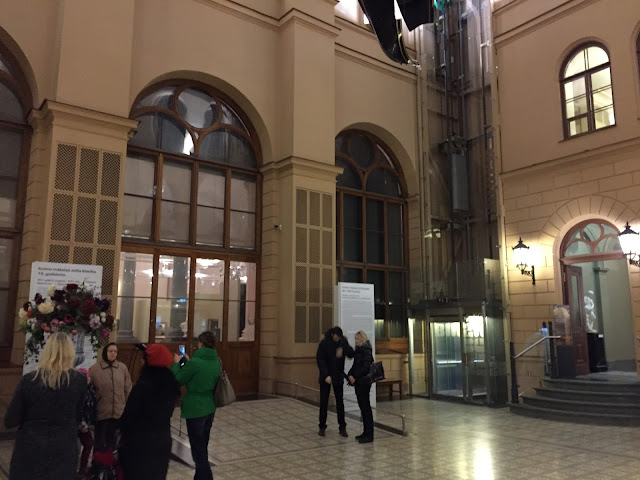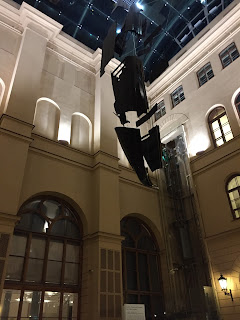198. Regional Travel #4.5 - Art Museum Riga Bourse
I stumbled upon the Art Museum Riga Bourse at the end of a long day of sightseeing in Latvia's capital city. I knew there was a museum in this spot (in the central square in Old Town Riga) from close examination of a map, but its location is not apparent from the facade of the building; there are no visible signs or banners to advertise its presence. I followed a group of people through a small door, which led down a passageway to an interior courtyard where the museum's main entrance is located.
The building itself has been recently renovated. It was originally constructed between 1852 and 1855 in the style of a Venetian renaissance palazzo, and used for decades as the home of the Riga Stock Exchange. It was designed by the German architect Harald Julius Bosse, who spent his entire career working out of St. Petersburg (including a stint as a professor at the Imperial Academy of Arts as well as an appointment as court architect). Although the museum traces its lineage through a series of other institutions that originated in the 1920s (including some that were housed in Riga Castle - most recently the Museum of Foreign Art), it was established in its current form at the beginning of this decade and is a new occupant of the site.
Riga Bourse has staged a cycle of exhibitions (beginning in 2012), each of which has been dedicated to a particular period of Russian art. When the series is complete, a comprehensive view of Russian art history (as documented in the Latvian National Museum's Russian art collection) will have been covered. The 150 works in the current special exhibit (primarily paintings, sculptures, and decorative arts) are from artists active during the 19th century. This is probably my favorite era of Russian art (and European art in general), so my visit to Riga was well timed. The main stylistic focus areas in the exhibit are on the Romanticist period during the first half of the century ("Under the Sign of Romanticism"), and the development of Realism during the second half of the century ("The Era of Realism"). Smaller thematic groupings include genre paintings from members of the Association of Traveling Art Exhibits, large format paintings from graduates of the St. Petersburg Academy of Arts, nature paintings of the Russian landscape, and portraits of prominent Russians.
The exhibit's signs and labels were in three languages: Latvian, followed by English, and then Russian. So, I learned quite a bit about the art, even though I've been enjoying works by many of the same artists at the State Russian Museum and the Hermitage in St. Petersburg. If I have the good fortune to visit Riga again someday, I will definitely return to the Art Museum Riga Bourse to see what treasures are on display in the museum's permanent exhibits on the several floors that I did not have the opportunity to enjoy during this visit.
Wilhelm Georg Timm - "Portrait of Nicholas I" (1843):
Karl Bryullov - "Portrait of Georg Kleberg" (ca. 1833):
Grigory Chernetsov - "Constantinople. View from Pera" (1862):
Wilhelm Georg Timm - "Portrait of a Negro" (1844):
Michail Clodt fon Jürgensburg - "Rye" (1868):
Ilya Repin - "A Man from Zaporozhye" (1880s):
Nikolai Bogdanov-Belsky - "Future Monk" (1890):
Vasily Perov - "Portrait of N.P. Lanin" (1869):
A variety of porcelain and lacquerware pieces:
There was a small exhibit in the museum basement (near the cloakroom and restrooms) on the design and reconstruction work to restore the Riga Stock Exchange building. Surprisingly, the project lasted only from September 30, 2014 until September 22, 2005. In the United States, most projects of this magnitude seem to last for at least two or three years. The restoration project attempted to maintain historical authenticity and also bring the facility into the 21st century. I was impressed with the entrance courtyard and Great Hall, so the project seems like a success from a functional and aesthetic perspective.





































Comments
Post a Comment